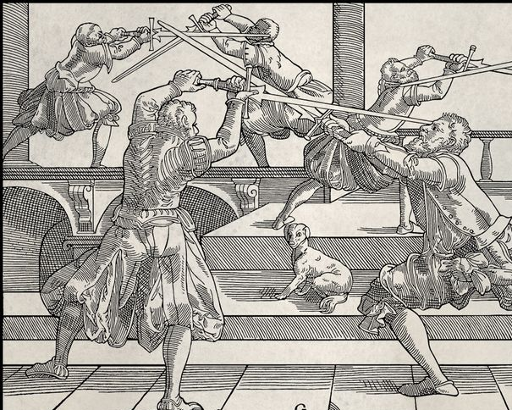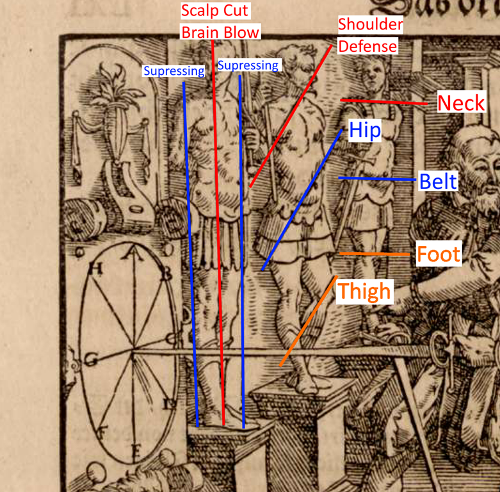Schielhauw
(→Application Example) |
|||
| Line 1: | Line 1: | ||
===Squinting Strike=== | ===Squinting Strike=== | ||
| + | |||
| + | ==Longsword== | ||
A [[meisterhauw]] and one of Meyer's secondary strikes, this blow parries with the false edge while simultaneously striking. Meyer's version of this strike hits with higher hands than many interpretations of the early German version of the blow. The low handed version which slides along the opponent's blade is identified by Meyer as [[Glutzhauw]]. | A [[meisterhauw]] and one of Meyer's secondary strikes, this blow parries with the false edge while simultaneously striking. Meyer's version of this strike hits with higher hands than many interpretations of the early German version of the blow. The low handed version which slides along the opponent's blade is identified by Meyer as [[Glutzhauw]]. | ||
| − | ==Execution== | + | ===Execution=== |
Meyer doesn't explicitly say what blow this cut parries, but his images suggest that it can be used against [[oberhauw]]/[[zornhauw]] or [[unterhauw]] with equal facility. The wording in the text states that the cut ends as the figures on the left in the image, one depicts a cut against an unterhauw, the other against an oberhauw. The execution according to the canonical description is: | Meyer doesn't explicitly say what blow this cut parries, but his images suggest that it can be used against [[oberhauw]]/[[zornhauw]] or [[unterhauw]] with equal facility. The wording in the text states that the cut ends as the figures on the left in the image, one depicts a cut against an unterhauw, the other against an oberhauw. The execution according to the canonical description is: | ||
| Line 14: | Line 16: | ||
As a matter of experience it's worth noting that often the schielhauw works best with a "flicking" forward motion of the blade rather than simply cutting across. The flick deflects the opponent's blade and brings the false edge weak of the blade over that much quicker. | As a matter of experience it's worth noting that often the schielhauw works best with a "flicking" forward motion of the blade rather than simply cutting across. The flick deflects the opponent's blade and brings the false edge weak of the blade over that much quicker. | ||
| − | ==Application== | + | ===Application=== |
The Schielhauw is useful for deflecting incoming blows and thrusts, but can also be used against opponent's standing in on-point guards such as [[Eisenport]] or [[Langort]], however fencers should beware of the opponent changing through beneath their blade ([[Durchwechseln]]). | The Schielhauw is useful for deflecting incoming blows and thrusts, but can also be used against opponent's standing in on-point guards such as [[Eisenport]] or [[Langort]], however fencers should beware of the opponent changing through beneath their blade ([[Durchwechseln]]). | ||
| − | ==Application Example== | + | ===Application Example=== |
In which the 'student' demonstrates their knowledge to the 'teacher'. | In which the 'student' demonstrates their knowledge to the 'teacher'. | ||
| Line 39: | Line 41: | ||
| Let the cut continue so it hits with the false edge to their head. | | Let the cut continue so it hits with the false edge to their head. | ||
|} | |} | ||
| + | |||
| + | ==Rappier== | ||
| + | |||
| + | Once again the cut with the rappier is similar to the longsword stroke, using a reversing of the hand in the strike so the false edge is turned toward the opponent. | ||
| + | |||
| + | ===Execution=== | ||
| + | The canonical unterhauw is performed as follows. | ||
| + | |||
| + | * Standing in [[Oberhut]] | ||
| + | * Cut down at his blade or strike and in the cut turn the blade so the impact occurs on the false edge or flat and the short edge strikes them in the head. Typically this is accompanied by an offline step ([[Triangle Step]]) | ||
| + | * If the cut fails, thrust into long point. | ||
| + | |||
| + | [[File:RappierCuttingLines.png | center]] | ||
Revision as of 14:42, 8 July 2016
Contents |
Squinting Strike
Longsword
A meisterhauw and one of Meyer's secondary strikes, this blow parries with the false edge while simultaneously striking. Meyer's version of this strike hits with higher hands than many interpretations of the early German version of the blow. The low handed version which slides along the opponent's blade is identified by Meyer as Glutzhauw.
Execution
Meyer doesn't explicitly say what blow this cut parries, but his images suggest that it can be used against oberhauw/zornhauw or unterhauw with equal facility. The wording in the text states that the cut ends as the figures on the left in the image, one depicts a cut against an unterhauw, the other against an oberhauw. The execution according to the canonical description is:
- Standing in a Vom tag or Zornhut
- As he cuts step forward and left with a Passing Step and cut in the style of a Zornhauw at the start, but wind the hands high as the cut is executed so their blade is deflected by your false edge, and you strike their head with high hands.
As a matter of experience it's worth noting that often the schielhauw works best with a "flicking" forward motion of the blade rather than simply cutting across. The flick deflects the opponent's blade and brings the false edge weak of the blade over that much quicker.
Application
The Schielhauw is useful for deflecting incoming blows and thrusts, but can also be used against opponent's standing in on-point guards such as Eisenport or Langort, however fencers should beware of the opponent changing through beneath their blade (Durchwechseln).
Application Example
In which the 'student' demonstrates their knowledge to the 'teacher'.
| Teacher | Student |
|---|---|
| Zornhut, left leg forward | Vom tag, left leg forward |
| Passing Step Zornhauw | Glide Step forward and right and cut diagonally down to his upper left opening. |
| As the cut moves forward turn the wind the hands so the pommel moves out to the left, keeping the hands quite high. This will deflect their blade with your false edge. | |
| Let the cut continue so it hits with the false edge to their head. |
Rappier
Once again the cut with the rappier is similar to the longsword stroke, using a reversing of the hand in the strike so the false edge is turned toward the opponent.
Execution
The canonical unterhauw is performed as follows.
- Standing in Oberhut
- Cut down at his blade or strike and in the cut turn the blade so the impact occurs on the false edge or flat and the short edge strikes them in the head. Typically this is accompanied by an offline step (Triangle Step)
- If the cut fails, thrust into long point.

